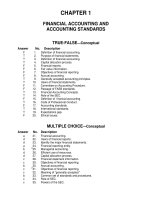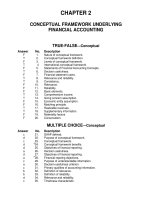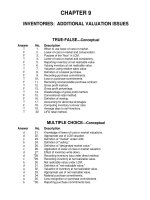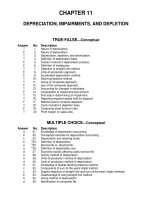Intermediate accounting 16e by kieso slide ch13
Bạn đang xem bản rút gọn của tài liệu. Xem và tải ngay bản đầy đủ của tài liệu tại đây (1.28 MB, 97 trang )
13-1
PREVIEW OF CHAPTER 13
Intermediate Accounting
16th Edition
Kieso ● Weygandt ● Warfield
13-2
13
Current Liabilities and Contingencies
LEARNING OBJECTIVES
After studying this chapter, you should be able to:
1
Describe the nature, valuation, and reporting of
current liabilities.
2
Explain the classification issues of short-term debt
3
Explain the accounting for gain and loss contingencies.
4
Indicate how to present and analyze liabilities and
contingencies.
expected to be refinanced.
13-3
LO 1
CURRENT LIABILITIES
“What is a Liability?”
The FASB, defined liabilities as:
“Probable Future Sacrifices of Economic Benefits arising from
present obligations of a particular entity to transfer assets or provide
services to other entities in the future as a result of past transactions or
events.”
13-4
LO 1
CURRENT LIABILITIES
Recall: Current assets are cash or other assets that companies reasonably expect to convert into cash, sell, or
consume in operations within a single operating cycle or within a year.
Current liabilities are “obligations whose liquidation is reasonably expected to require use of existing
resources properly classified as current assets, or the creation of other current liabilities.”
Operating cycle: Period of time elapsing between the acquisition of goods and services and the final cash realization resulting
from sales and subsequent collections.
13-5
LO 1
CURRENT LIABILITIES
Typical Current Liabilities:
Accounts payable.
Customer advances and deposits.
Notes payable.
Unearned revenues.
Current maturities of long-term debt.
Sales taxes payable.
Short-term obligations expected to be
Income taxes payable.
Employee-related liabilities.
refinanced.
13-6
Dividends payable.
LO 1
CURRENT LIABILITIES
Accounts Payable (trade accounts payable)
Balances owed to others for goods, supplies, or services purchased on open account.
Time lag between the receipt of services or acquisition of title to assets and the payment for them.
Terms of the sale (e.g., 2/10, n/30 or 1/10, E.O.M.) usually state period of extended credit, commonly
30 to 60 days.
13-7
LO 1
CURRENT LIABILITIES
Notes Payable
Written promises to pay a certain sum of money on a specified future date.
13-8
Arise from purchases, financing, or other transactions.
Classified as short-term or long-term.
May be interest-bearing or zero-interest-bearing.
LO 1
CURRENT LIABILITIES
Interest-Bearing Note Issued
Illustration: Castle National Bank agrees to lend $100,000 on March 1, 2017, to Landscape Co. if Landscape signs
a $100,000, 6 percent, four-month note. Landscape records the cash received on March 1 as follows:
Cash 100,000
Notes Payable
13-9
100,000
LO 1
CURRENT LIABILITIES
If Landscape prepares financial statements semiannually, it makes the following adjusting entry to recognize
interest expense and interest payable at June 30:
Interest calculation =
Interest Expense
($100,000 x 6% x 4/12) = $2,000
2,000
Interest Payable
13-10
2,000
LO 1
CURRENT LIABILITIES
At maturity (July 1), Landscape records payment of the note and accrued interest as follows.
Notes Payable
100,000
Interest Payable
2,000
Cash
13-11
102,000
LO 1
CURRENT LIABILITIES
Zero-Interest-Bearing Note Issued
Illustration: On March 1, Landscape issues a $102,000, four-month, zero-interest-bearing note to Castle National
Bank. The present value of the note is $100,000. Landscape records this transaction as follows.
Cash 100,000
Discount on Notes Payable
Notes Payable
13-12
2,000
102,000
LO 1
CURRENT LIABILITIES
Discount on Notes Payable is a contra account to Notes Payable, and therefore is subtracted from Notes
Payable on the balance sheet.
ILLUSTRATION 13-1
Balance Sheet Presentation of Discount
Discount on notes payable:
13-13
Represents the cost of borrowing.
Debited to interest expense over the life of the note.
Represents interest expense chargeable to future periods.
LO 1
CURRENT LIABILITIES
Illustration: (Accounts and Notes Payable) The following are selected 2017 transactions of Darby Corporation.
Sept. 1 - Purchased inventory from Orion Company on account for $50,000. Darby records purchases gross
and uses a periodic inventory system.
Oct. 1 - Issued a $50,000, 12-month, 8% note to Orion in payment of account.
Oct. 1 - Borrowed $75,000 from the Shore Bank by signing a 12-month, zero-interest-bearing $81,000 note.
Prepare journal entries for the selected transactions.
13-14
LO 1
CURRENT LIABILITIES
Sept. 1 - Purchased inventory from Orion Company on account for $50,000. Darby records purchases gross
and uses a periodic inventory system.
Sept. 1
Purchases
Accounts Payable
13-15
50,000
50,000
LO 1
CURRENT LIABILITIES
Oct. 1 - Issued a $50,000, 12-month, 8% note to Orion in payment of account.
Oct. 1
Accounts Payable
50,000
Notes Payable
Interest calculation =
Dec. 31
($50,000 x 8% x 3/12) = $1,000
Interest Expense
Interest Payable
13-16
50,000
1,000
1,000
LO 1
CURRENT LIABILITIES
Oct. 1 - Borrowed $75,000 from the Shore Bank by signing a 12-month, zero-interest-bearing $81,000 note.
Oct. 1
Cash
75,000
Discount on Notes Payable
6,000
Notes Payable
Interest calculation =
Dec. 31
($6,000 x 3/12) = $1,500
Interest Expense
Discount on Notes Payable
13-17
81,000
1,500
1,500
LO 1
CURRENT LIABILITIES
Dividends Payable
Amount owed by a corporation to its stockholders as a result of board of directors’ authorization.
13-18
Generally paid within three months.
Undeclared dividends on cumulative preferred stock not recognized as a liability.
Dividends payable in the form of additional shares of stock are reported in stockholders’ equity.
LO 1
CURRENT LIABILITIES
Customer Advances and Deposits
Returnable cash deposits received from customers and employees.
13-19
To guarantee performance of a contract or service or
as guarantees to cover payment of expected future obligations.
May be classified as current or long-term liabilities.
LO 1
CURRENT LIABILITIES
Unearned Revenues
Payment received before delivering goods or rendering services.
ILLUSTRATION 13-3
Unearned and Earned Revenue Accounts
13-20
LO 1
CURRENT LIABILITIES
Illustration: Allstate University sells 10,000 season football tickets at $50 each for its five-game home schedule.
Allstate University records the sales of season tickets as follows.
Aug. 6
Cash
500,000
Unearned Sales Revenue
500,000
(10,000 x $50 = $500,000)
As each game is completed, Allstate makes the following entry.
Sept. 7
Unearned Sales Revenue
Sales Revenue
100,000
100,000
($500,000 ÷ 5 games = $100,000 per game)
13-21
LO 1
WHAT DO THE NUMBERS MEAN?
MICROSOFT’S LIABILITIES—GOOD OR BAD?
WHAT’S YOUR PRINCIPLE
Users of financial statements generally examine current liabilities to assess a company’s liquidity and overall financial flexibility.
Companies must pay many current liabilities, such as accounts payable, wages payable, and taxes payable, sooner rather than
later. A substantial increase in these liabilities should raise a red flag about a company’s financial position. This is not the case for
all current liabilities. For example, Microsoft has a current liability entitled “Short-term unearned revenue” of $25,318 million in
2015 that has increased year after year. Unearned revenue is a liability that arises from sales of Microsoft products such as
Internet Explorer and Windows.
Microsoft also has provided coupons for upgrades to its programs to bolster sales of its XBox consoles and Surface tablets. At
the time of a sale, customers pay not only for the current version of the product but also for future upgrades. Microsoft recognizes
sales revenue from the current version of the software or product and records as a liability (unearned revenue) the value of future
upgrades that it “owes” to customers.
13-22
(continued)
LO 1
WHAT DO THE NUMBERS MEAN?
MICROSOFT’S LIABILITIES—GOOD OR BAD?
WHAT’S YOUR PRINCIPLE
Market analysts read such an increase in unearned revenue as a positive signal about Microsoft’s sales and profitability. When
Microsoft’s sales are growing, its unearned revenue account increases. Thus, an increase in a liability is good news about
Microsoft sales. At the same time, a decline in unearned revenue is bad news. As one analyst noted, a slowdown or reversal of
the growth in Microsoft’s unearned revenues indicates slowing sales, which is bad news for investors. Thus, increases in current
liabilities can sometimes be viewed as good signs instead of bad.
Sources: Adapted from David Bank, “Some Fans Cool to Microsoft, Citing Drop in Old Indicator,” Wall Street Journal (October 28, 1999); Bloomberg News,
“Microsoft Profit Hit by Deferred Sales; Forecast Raised,” The Globe and Mail (January 26, 2007), p. B8; and D. Bass, “Microsoft Unearned Revenue Tops
Estimates on Upgrades,” Bloomberg Business (July 19, 2012).
13-23
LO 1
CURRENT LIABILITIES
Sales Taxes Payable
Retailers must collect sales taxes from customers on transfers of tangible personal property and on certain
services and then remit to the proper governmental authority.
13-24
LO 1
CURRENT LIABILITIES
Illustration: Prepare the entry to record sales taxes assuming there was a sale of $3,000 when a 4 percent sales
tax is in effect.
Cash 3,120
Sales Revenue
Sales Taxes Payable ($3,000 x 4% = $120)
13-25
3,000
120
LO 1









